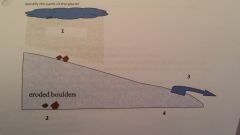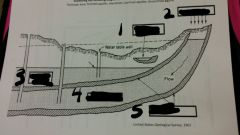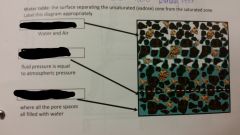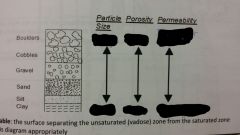![]()
![]()
![]()
Use LEFT and RIGHT arrow keys to navigate between flashcards;
Use UP and DOWN arrow keys to flip the card;
H to show hint;
A reads text to speech;
25 Cards in this Set
- Front
- Back
|
True or False:
The inner core is a solid mass composed of mainly nickel and iron. |
TRUE |
|
|
True or False: Because of plate tectonics, the Atlantic Ocean is becoming wider |
TRUE |
|
|
True or False: The Precambrian Shield is one of the oldest known formations on the planet-- dating about 400 million years. |
FALSE: The oldest rocks on earth are 4.6 billion years old |
|
|
True or False: Currently 35% of the Earth's surface is covered by glaciers. |
FALSE: 10% of the Earth's surface is covered by glaciers |
|
|
True or False: The direction of ice flow depends on whether the glacier is in advance, recession, or retreat. |
FALSE: The flow of ice is always moving down slope no matter what the state of motion
|
|
|
Choose all of the following which are correct about the Mantle of the Earth: a) Makes up for about 80% of the Earth's total volume b) Rocks here are solid, but plastic in nature c) The minerals making up the rocks are high in magnesium and iron d) It's about 75 km thick |
A, B, C |
|
|
Choose the best definition for an igneous rock: a) Formed through the lithification and compaction of weathered sediments formed through addition of heat and pressure to existing rocks b) Formed through the cooling and crystallization of molten material c) Can form intrusive or Extrusive rocks |
B |
|
|
Describe the process of lithification. Hint: |
The process in which sediments compact under pressure and cements the fragments to form new sedimentary rocks.
|
|
|
Banding is a phenomenon that is known to occur in which type of rocks? a) Igneous plutonic b) Igneous volcanic c) Sedimentary d) Metamorphic e) None of the above |
D and B |
|
|
Choose all of the following which are correct: a) Magma is molten rock which is below the Earth's surface b) Rocks which form magma are known as intrusive igneous rocks c) Intrusive igneous rocks cool slowly allowing the minerals within them to grow large enough to discern with the naked eye d) Rocks which form from lava are known as extrusive igneous rocks e) Extrusive igneous rocks cool so rapidly that the individual minerals are too fine grained to see with the naked eye |
All of the above |
|
|
Which of the physiographic region(s) has sedimentary bedrock geology? a) Precambrian Shield b) Hudson Bay Lowlands c) St. Lowrance Lowlands |
B and C
|
|
|
A period of _______________ is experienced by a continental glacier when the input of new snow in the north equals the rate of melting in the south. |
Recession |
|
|
Choose all of the following which is true of till: a) Unstratified b) Well-graded c) Rounded Fragments d) Occurs in water contact features e) Can be found in eskers and schomberg ponds f) Poorly sorted |
A, B, F |
|
|
Choose all of the following which would be correct about the soils of the St. Lowrance Lowlands. a) Have high water retention ability b) Are generally slightly acidic in nature c) Are generally thick and loamy d) Generally sandy e) Have high nutrient levels |
A, C, E |
|

Identify the parts of the glacier. |
1: Snow Falls 2. Zone of accumulation 3. Ice Melts 4. Zone of wasting |
|

Identify the parts of the diagram. |
1. Perched Aquifer 2. Recharge Area 3. Unconfined Aquifer 4. Confined Aquifer 5. Aquitard |
|

Label the diagram, top to bottom. |
Top: Vadose Zone Middle: Water Table Bottom: Saturated Zone |
|

Label the diagram, top to bottom, left to right. |
Particle Size: Large -> Small Porosity: Less -> More Permeability: Excellent -> Poor |
|
|
How does groundwater recharge? |
1. Precipitation 2. Infiltration |
|
|
Groundwater flows ____________ and discharges into:
a) Springs b) Streams c) Wells |
Downhill |
|
|
What is the process of infiltration? |
The process by which water enters the soil surface. |
|
|
How can infiltration be reduced in the environment? |
1. Change the drainage pattern 2. Add impermeable surfaces |
|
|
Run off occurs when the rainfall rate is greater than ____________. |
The infiltration capacity. |
|
|
Choose the best answer: Forested soils have the greatest infiltration rate because of: a) Organic litter at the surface b) Root cavities c) Burrowing animals d) Earthworms e) Leaves and Branches e) All of the above |
E |
|
|
What is the difference between drift and till? |
Till is deposited by glaciers; unsorted particle sizes. Drift is laid down by melt water; sorted according to size and weight. |

